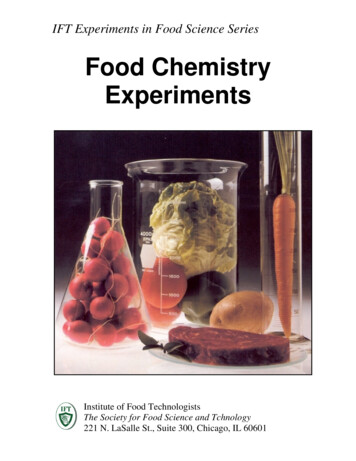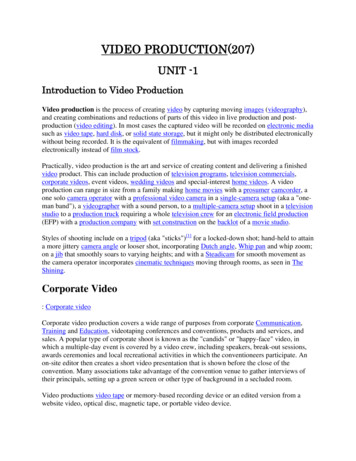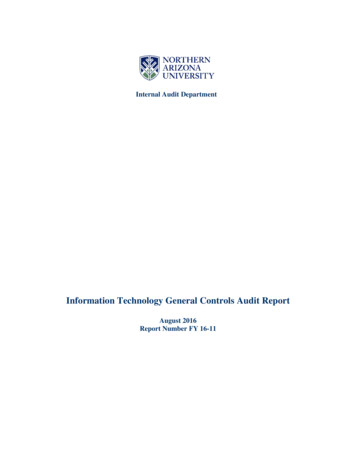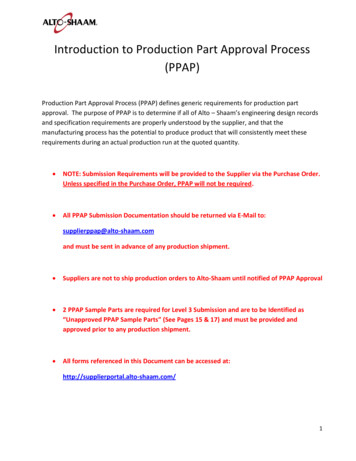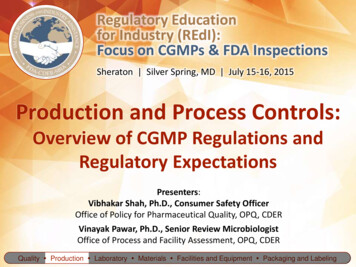
Transcription
Regulatory Educationfor Industry (REdI):Focus on CGMPs & FDA InspectionsSheraton Silver Spring, MD July 15-16, 2015Production and Process Controls:Overview of CGMP Regulations andRegulatory ExpectationsPresenters:Vibhakar Shah, Ph.D., Consumer Safety OfficerOffice of Policy for Pharmaceutical Quality, OPQ, CDERVinayak Pawar, Ph.D., Senior Review MicrobiologistOffice of Process and Facility Assessment, OPQ, CDERQuality Production Laboratory Materials Facilities and Equipment Packaging and Labeling
The Six Components Quality Production Laboratory Materials Facilities &Equipment Packaging &LabelingQuality Production Laboratory Materials Facilities and Equipment Packaging and Labeling2
Overview Public Health and Product Quality Expectations Pharmaceutical Manufacturing Operation Production Relevant CGMP Regulations Regulatory Tools for Compliance Regulatory Expectations Summary QuestionsQuality Production Laboratory Materials Facilities and Equipment Packaging and Labeling
Public Health - ExpectationsPublic Health Care System - Stakeholders Patients/Consumers Expects reliable access to safe, efficacious, stable and affordablehigh quality pharmaceuticals Manufacturers Manage reliable and secure supply chain Maintain risk mitigated, reliable, and efficient manufacturingoperations Provide safe, efficacious, and defect-free high quality drugproducts Regulators Stand in for the consumer (patient) to ensure quality Exercise risk-commensurate regulatory oversightQuality Production Laboratory Materials Facilities and Equipment Packaging and Labeling
Drug Regulation FrameworkLegalRegulatoryFrameworkQuality Production Laboratory Materials Facilities and Equipment Packaging and Labeling5
Drug Regulation FrameworkStatuteFD&C Act Section 501(a)(2)(B)“A drug shall be deemed to be adulterated if themethods used in, or the facilities or controls used for,its manufacture, processing, packing, or holdingdo not conform to or are not operated or administeredin conformity with current good manufacturing practiceto assure that such drugmeets the requirements of this Act as to safety and hasthe identity and strength, and meets the quality andpurity characteristics, which it purports or is representedto possess.”Quality Production Laboratory Materials Facilities and Equipment Packaging and Labeling6
Current Good Manufacturing Practice (CGMP)Legal Basis FD&C Act Sec. 501(a)(2)(B) –requires conformity with CurrentGood Manufacturing Practice(CGMP) for manufacture of drugs No distinction between API,excipients and finishedpharmaceuticals CGMP regulations - Agency’sinterpretation of the statute forcompliance cfCFR/CFRSearch.cfm?CFRPart 210 cfCFR/CFRSearch.cfm?CFRPart 211Quality Production Laboratory Materials Facilities and Equipment Packaging and Labeling7
CGMP Regulations : Law of the LandCGMPs21 CFR 3(b)(3)Component210.3(b)(4)Drug productCGMPs21 CFR 211SubpartsFD&C Act Section 501(a)(2)(B)210.3(b)(20)AcceptanceCriteria“A drug shall be deemed to be adulteratedif.the methods used in, or the facilities or controls used for, its manufacture,processing, packing, or holdingCGMPsdo not conform to or are not operated oradministered in conformitywith21 CFRcurrent210 good manufacturingpractice. to b)(15)Quality ControlUnitthat such drug meets the requirements of this Act as to safetyand has the identity and strength, and meets the quality andpurity characteristics, which it purports or is represented 3(b)(2)Batch210.3(b)(10)LotQuality Production Laboratory Materials Facilities and Equipment Packaging and Labeling 8
CGMP Regulations : Law of the LandSUBPART ACGMPs21 CFR 210DefinitionsGeneral Provisions211.1, 211.3SUBPART KCGMPs21 CFR 211SubpartsSUBPART BReturned & SalvagedDrug products211.204 .Organizations &Personnel211.22 FD&C Act Section 501(a)(2)(B)SUBPART JRecords and Reports211.180 .SUBPART ILaboratory Controls211.160 “A drug shall be deemed to be adulteratedif.the methods used in, or the facilities or controlsused for, its manufacture, processing, packing, orholding do not conformto or are not operated orCGMPsadministered in conformitywith current good21 CFR 211manufacturing practice. to assureSUBPART CBuildings & Facility211.42 .SUBPART DEquipment211.63 .that such drug meets the requirements of thisAct as to safety and has the identity andstrength, and meets the quality and puritycharacteristics, which it purports or isSUBPART HSUBPART EHolding &represented to possess.”Components & CCSDistribution211.142 .211.80 SUBPART GSUBPART FPackaging &Labeling Controls211.122 .Production &Process Controls211.100 .Quality Production Laboratory Materials Facilities and Equipment Packaging and Labeling9
CGMP Regulations: Production System21 CFR 211 Subpart FProduction and Process Controls Applies to Finished drug products Prescription drug products (Rx) NDA, ANDA, BLAsOver-The-Counter drug products (OTC)Unapproved drugsCompounded drugs (under Sec. 503B of the Act)Any type of Method of Manufacture Batch, Semi-continuous, ContinuousAseptic, Sterile, BiotechnologyQuality Production Laboratory Materials Facilities and Equipment Packaging and Labeling 10
Production System Production System includes measures and activities to control the manufacture ofin-process materials and drug products including batch compoundingdosage form productionin-process sampling and testing andprocess validation establishing,following, and documentingperformance of approved manufacturing procedures See 21 CFR 211 Subparts B, F, I, and JQuality Production Laboratory Materials Facilities and Equipment Packaging and Labeling 11
Typical Pharmaceutical Manufacturing OperationsLiquids/SuspensionsSolid Orals:Tablets, capletsDrug-DeviceNasal Sprays, MDI. ingFiltration*Dosage Form FormationCompression, FillingCCS Filling**Coating, polishingPackagingPackagingDevice FillingDevice AssemblyPackagingQuality Production Laboratory Materials Facilities and Equipment Packaging and Labeling 12
21 CFR 211 Subpart FProduction and Process Controls§ 211.100 § 211.101 § 211.103 § 211.105 § 211.110 § 211.111 § 211.113 § 211.115 -Written procedures; deviationsCharge-in of componentsCalculation of yieldEquipment identificationSampling and testing of in-process materials and drug productsTime limitations on production.Control of microbiological contaminationReprocessingSubpart I - Laboratory Controls: § 211.160(b)(2)(3) - Sampling procedures forin-process materials and finished drug productsSubpart J - Records and Reports: § 211.180(e)(2)(3) - Annual Product Review§ 211.192 – Production Record Review, Deviation and investigationQuality Production Laboratory Materials Facilities and Equipment Packaging and Labeling 13
§ 21 CFR 211.100Written procedures; deviations – Key points(a) Requires written procedures for production and process control designed to assure that the drug products have the identity,strength, quality, and purity they purport or represent to possess.shall include all requirements in this Subpart FResponsibility of the appropriate organizational units todraft the procedures including any changes, review, and approveResponsibility of the quality control unit to review and approve(b) The written PPC procedures shall be followed in the execution of the various production and processcontrol (PPC) functionsdocumented at the time of performanceany deviation from the written procedures shall be recorded andjustifiedQuality Production Laboratory Materials Facilities and Equipment Packaging and Labeling 14
§ 21 CFR 211.101Charge-in of components – Key pointsWritten PPC procedures shall include the following:(a) The batch shall be formulated with the intent to provide not lessthan 100 percent of the labeled or established amount of activeingredient(b) Components for drug product manufacturing shall be weighed,measured, or subdivided as appropriate. If a component is removed from the original container to another,the new container shall be identified with the following information:(1) Component name or item code;(2) Receiving or control number;(3) Weight or measure in new container;(4) Batch for which component was dispensed, including its productname, strength, and lot number.Quality Production Laboratory Materials Facilities and Equipment Packaging and Labeling 15
§ 21 CFR 211.101Charge-in of Components – Key pointsWritten PPC procedures shall include the following:(c) Weighing, measuring, or subdividing & dispensing of componentsManual operation: Requires adequate supervision by a second Second person must examine and assure(1) release of the components to Mfg. by the quality control unit (QCU)(2) the weight/measure matches the Batch Production Records (BPRs)(3) proper identification of the containersAutomated equipment Operation (211.68): Requires only one person to verify theses operations and assure (c)(1)-(3)(d) Component addition: (e.g., order of addition) Manual Operation: Require one person to add and a second to verify Automated equipment Addition(211.68): Require one person to verifyQuality Production Laboratory Materials Facilities and Equipment Packaging and Labeling 16
§ 21 CFR 211.103Calculation of yield – Key points Requires determination of actual yields and %theoretical yield at the conclusion of each appropriate phase of manufacturing,processing, packaging, or holding of the drug product. Yield calculations performed by one person independently verified by a second person Yield calculations by automated equipment (211.68) independently verified by one personQuality Production Laboratory Materials Facilities and Equipment Packaging and Labeling 17
21 CFR 211.105Equipment identification – Key points(a) Requires proper identification (ID) of all equipment at all timesduring production compounding and storage containersprocessing linesmajor equipment to indicate their contents to indicate the phase of processing of the batch when necessary(b) Requires identification and recording of a major equipment by adistinctive ID number or code in the batch production record to show the use of a specific equipment for manufacture of each DP batchID by equipment name allowed in lieu of a distinctive ID number or code if only one of a particular type of equipment exists in a facilityQuality Production Laboratory Materials Facilities and Equipment Packaging and Labeling 18
§ 21 CFR 211.110 - Sampling & testing ofin-process materials & drug products – Key points(a) Requires establishing and following written procedures To assure batch uniformity and integrity of drugproducts That describe the in-process controls, and tests, orexaminations to be conducted on appropriate samples of in-process materials of each batch To monitor the output and validate the performanceof those manufacturing processes responsible for causing variability in the characteristics ofin-process material and the drug productQuality Production Laboratory Materials Facilities and Equipment Packaging and Labeling 19
§ 21 CFR 211.110 - Sampling & testing ofin-process materials & drug products - Key points(a) Requires establishing and following written procedures Such control procedures shall include, but are notlimited to, the following (characteristics), whereappropriate:(1) Tablet or capsule weight variation(2) Disintegration time(3) Adequacy of mixing to assure uniformity andhomogeneity(4) Dissolution time and rate(5) Clarity, completeness, or pH of solutions(6) Bioburden testingQuality Production Laboratory Materials Facilities and Equipment Packaging and Labeling 20
§ 21 CFR 211.110 - Sampling & testing ofin-process materials & drug products - Key points(b) Requires establishing valid in-process specifications forsuch characteristics shall be consistent with drug product final specifications shall be derived from previous acceptable processaverage and process variability estimates where possible determined by the application of suitable statisticalprocedures where appropriate. Examination and testing of samples shall assure that thedrug product and in-process material conform tospecifications.Quality Production Laboratory Materials Facilities and Equipment Packaging and Labeling 21
§ 21 CFR 211.110 - Sampling & testing ofin-process materials & drug products - Key points(c) Requires testing of in-process materials for identity,strength, quality, and purity as appropriateRequires the quality control unit to approve or reject thein-process materials during the production process, e.g., at commencement or completion of significant phases or after storage for long periods(d) Requires identification and control of the rejected in-process materials under a quarantine system designed to prevent their use in manufacturing orprocessing operations for which they are unsuitableQuality Production Laboratory Materials Facilities and Equipment Packaging and Labeling 22
§ 21 CFR 211.111Time limitations on production- Key points Requires to establish time limits for the completion ofeach phase of production when appropriate to assure the quality of the drug product. Any deviation from established time limits may beacceptable if such deviation does not compromise the quality of the drugproduct. Such deviation shall be justified and documented.Quality Production Laboratory Materials Facilities and Equipment Packaging and Labeling 23
§ 21 CFR 211.113Control of microbiological contamination(a) Appropriate written procedures, designed to preventobjectionable microorganisms in drug products notrequired to be sterile, shall be established and followed.(b) Appropriate written procedures, designed to preventmicrobiological contamination of drug productspurporting to be sterile, shall be established andfollowed. Such procedures shall include validation of allaseptic and sterilization processes.Dr. Pawar will cover these aspects in his presentationQuality Production Laboratory Materials Facilities and Equipment Packaging and Labeling 24
§ 21 CFR 211.115Reprocessing - Key Points(a) Requires establishing and following procedures Prescribing a system for reprocessing batches thatdo not conform to standards or specifications Steps to insure that the reprocessed batches willconform with all established standards,specifications, and characteristics(b) Reprocessing shall not be performed without thereview and approval of the quality control unit.Quality Production Laboratory Materials Facilities and Equipment Packaging and Labeling 25
Sec. 21 CFR 211.160 (b)General requirements - Key PointsIn-process Materials:(2) Requires determination of conformance towritten specifications and sampling and testingprocedures samples shall be representative and properly identified Drug Products:(3) Requires determination of conformance towritten descriptions of sampling procedures andappropriate specifications for drug products. samples shall be representative and properly identified Quality Production Laboratory Materials Facilities and Equipment Packaging and Labeling 26
Sec. 21 CFR 211.180 (e)General requirements – Key Points(e) Requires maintaining and evaluating written records and data atleast annually to evaluate the quality standards of each drug product to determine the need for changes in drug productspecifications or manufacturing or control proceduresRequires establishing and following procedures for suchevaluations and include provisions for:(1) A review of a representative number of batches, whetherapproved or rejected, and, where applicable, recordsassociated with the batch.(2) A review of complaints, recalls, returned or salvaged drugproducts, and investigations conducted under 211.192 foreach drug productQuality Production Laboratory Materials Facilities and Equipment Packaging and Labeling 27
Sec. 21 CFR 211.192Production Record Review- Key Points Requires thorough investigation of any unexplaineddiscrepancy whether or not the batch has already beendistributed exceeding the maximum or minimum of a theoretical yieldestablished in master production and control recordsfailure of a batch or any of its components to meet any of itsspecifications Requires to extend investigation to other batches same drug product and other drug products that may have beenassociated with the specific failure or discrepancy Requires a written record of the investigation withconclusions and follow-upQuality Production Laboratory Materials Facilities and Equipment Packaging and Labeling 28
Regulatory Tools for ProcessMonitoring, Control&Continuous ProcessVerificationICH Q8(R2) - Pharmaceutical Development (PD)FDA’s Process Analytical Technology (PAT) GuidanceICH Q9 – Quality Risk Management (QRM)FDA’s Quality Systems Guidance & ICH Q10 Pharmaceutical Quality Systems (PQS)ICH Q11 – Development and Manufacture of Drug SubstancesFDA’s Process Validation (PV) GuidanceQuality Production Laboratory Materials Facilities and Equipment Packaging and Labeling 29
PAT, QbD and Process Validation (PV)A robust Commercial Process Ultimate goal of QbD and PAT is to design and deliver an efficientcommercial process by Establishing scientific foundation for technology transfer from lab, pilot,and sub-commercial scale manufacturing activities Goal of process validation is to demonstrate with sufficiently rigorousscientific evidence and statistical measures that the designedcommercial process works as intendedremains under state of control (validated) all the timecapable of delivering quality product reliablyproduct and process deviations can be explained scientifically withidentifiable root causesproactive rather than reactive Change Control Managementprovides mechanism for continuous process verification and continualimprovement over lifecycleQuality Production Laboratory Materials Facilities and Equipment Packaging and Labeling 30
PAT Framework - Central Thesis Quality cannot be tested into products; it should be built-in (i.e.,by design) and verified during the process to the extent possiblerather than relying alone on end product testing Source(s) and range(s) of variability in raw materials (attributes),in-process materials (attributes), and process parameters needto be identified; impact of such variability on product qualityneeds to be understood and their acceptable ranges becontrolled Timely measurement and management of such variabilitythrough process understanding, monitoring and risk-mitigatingcontrol strategies can facilitate Real Time Releaseimprove quality and productivity throughout product’s lifecycleQuality Production Laboratory Materials Facilities and Equipment Packaging and Labeling 31
QbD Approach Example ntrolstrategyContinualImprovement Define Quality Target Product Profile (QTPP) Relating to quality, safety and efficacy and route of administration, dosage form, bioavailability, strength, andstability Determine critical quality attributes (CQAs) for an API,excipients, in-process materials and the drug product having an impact on product quality Select an appropriate manufacturing process Link material attributes and process parameters to CQAsand perform risk assessment Develop a design space Define, design and implement a control strategy Real-time release testing Manage product lifecycle, including continual improvementQuality Production Laboratory Materials Facilities and Equipment Packaging and Labeling 32
Process Validation - A lifecycle approach Stage 1, Process Design: Lab, pilot, small scale and commercial scale studies to establishprocess; process/product development Stage 2, Process Performance Qualification (PPQ): Facility, utilities and equipmentPerformance Qualification (confirm commercial process design) Stage 3, Continued Process Verification (CPV): Monitor, collect information, assess during commercializationMaintenance, continuous verification, process improvement Requires Statistical Quality Control criteria for Appropriate acceptance or rejection levelsQuality Production Laboratory Materials Facilities and Equipment Packaging and Labeling 33
Process validation - A lifecycle approachStage 1: Process Design The goal of this stage is to design a process suitable for routine commercial manufacturing that can consistentlydeliver a product that meets its critical quality attributesimportant to understand the degree to which models represent thecommercial process Control of the process through operational limits and in-processmonitoring is essential where the product attribute is not readily measurable due to limitationsof sampling or detectability (e.g., viral clearance or microbialcontamination), orwhen intermediates and products cannot be highly characterized andwell-defined quality attributes cannot be identified. Use of Process Analytical Technology (PAT) is encouragedQuality Production Laboratory Materials Facilities and Equipment Packaging and Labeling 34
Process validation - A lifecycle approachStage 2: Process Qualification Two elements: Design of the facility and qualification of the equipment andutilitiesProcess Performance Qualification confirming the commercialprocess design Accumulation of enough data and knowledge aboutthe commercial production process is expected must follow CGMP-compliant proceduresto support post-approval commercial distribution successfulcompletion of PPQ necessary Products manufactured during this stage, if acceptable,can be released under certain situationsQuality Production Laboratory Materials Facilities and Equipment Packaging and Labeling 35
Process validation - A lifecycle approachStage 3: Continued Process Verification The goal of the third validation stage is to continually assure thatthe process remains in a state of control (the validated state)during commercial manufacture Recommends continued monitoring and/or sampling at the level established during the PPQ stage until sufficient data isavailable to generate significant variability estimates Once the variability is known, sampling and/or monitoring should beadjusted to a statistically appropriate and representative level Process variability should be periodically assessed and samplingand/or monitoring adjusted accordingly Requires Statistical Quality Control criteria for Appropriate acceptance or rejection levelsQuality Production Laboratory Materials Facilities and Equipment Packaging and Labeling 36
Regulatory Tools for ComplianceCGMP Compliance ProgramsPre-approval Inspection: 7346.832: Pre-Approval Inspections/Investigations Readiness for Commercial ManufacturingConformance to ApplicationData Integrity AuditPost-Approval Inspection: 7346.843: Post-Approval Audit Inspections 7356.002: Drug Process Inspections (sub-programs follow ) 7356.002A: Sterile Drug Process Inspections7356.002B: Drug Repackers and relabelers7356.002C: Radioactive Drugs7356.002E: Compressed Medical Gases7356.002F: Active Pharmaceutical Ingredients Process Inspections7356.002M: Inspections of Licensed Biological Therapeutic DPs7356.002P: Positron Emission TomographyQuality Production Laboratory Materials Facilities and Equipment Packaging and Labeling 37
CGMP Inspection Coverage Examples Actual conditions and practices Raw Material Quality State of maintenance of equipment, and facilities Personnel -- Actual Operations, Procedures, Training Changes in manufacturing and laboratory Adequacy of design (discussed 18x in CGMP regulations) Latest stability data Process Implementation and experience Process Validation, lifecycle improvementsBatch trends: latest in-process control data Complaints, returns, deviations, failures, OOS and CAPA Reporting requirements met for Field Alerts, APRs, ADEs, BPDRs, CMCPhase 4 CommitmentsQuality Production Laboratory Materials Facilities and Equipment Packaging and Labeling 38
Regulatory Expectations Leverage the scientific knowledge derived from the product/process development and scale-up studies designed systematically by utilizing well established materialscience, (process) control systems engineering and qualityrisk management principles In developing a well-controlled, validated and robustcommercial manufacturing process, ready to deliver product of intended quality reliably overthe product’s lifecycleQuality Production Laboratory Materials Facilities and Equipment Packaging and Labeling 39
Summary: Quality Assurance Under CMC & GMPChangeManagementProcessValidation& ransfer &Scale UpControlStrategyQuality Production Laboratory Materials QualityRiskManagementFacilities and Equipment Packaging and Labeling40
Summary: Quality Assurance Under CMC & CGMPImproveitProveitSayWhat You DoDo What YouSayIn theory, there is no difference between theory and practice. But, in practice, there is.Quality Production Laboratory Materials Facilities and Equipment Packaging and Labeling 41
Regulatory Educationfor Industry (REdI):Focus on CGMPs & FDA InspectionsSheraton Silver Spring, MD July 15-16, 2015Microbiological overview ofBiopharmaceuticalProduction & ProcessPresenter:Vinayak Pawar, Ph.D. Senior Review MicrobiologistOffice of Process and Facilities, OPQ, CDERQuality Production Laboratory Materials Facilities and Equipment Packaging and Labeling
The Components for Discussion Overview of Production & Process ControlSubpart F – Production & Process ControlQuality21 CFR 211211.113 Microbial Objectionable Microorganisms & Products at Risk I. Non-SterileII. Multi-dose Products III. Sterile Products –A. Terminally sterilized orB. Aseptically Filled A. Terminally Sterilized Products – Regulatory requirements ¶metric release B. Aseptically Filled Products – Regulatory Requirements andControl of Aseptic manufacturing process & Environment.Quality Production Laboratory Materials Facilities and Equipment Packaging and Labeling
Overview of Production and Process Controls General - 21 CFR 211 - Subpart FProduction & Process Control- Procedures for production and process control designed to assure thatthe drug products have the identity, strength, quality, and purity theypurport topossess.- Such procedures shallinclude all requirements in this subpart. 21 CFR211 110(a)- Any Deviation from the written procedures shall be recorded and justified.21 CFR 211 110(b) Microbial Quality – 21 CFR 211.113 Control of microbiological contaminationprocedures, designed to prevent objectionablenot required to be sterile, shall be(a) Appropriate writtenmicroorganisms in drug productsestablished and followed.(b) Appropriate written procedures, designed to prevent microbiologicalcontamination of drug products purporting to be sterile, shall beestablishedand followed. Such procedures shall include validation ofany sterilizationprocess.Quality Production Laboratory Materials Facilities and Equipment Packaging and Labeling
Objectionable Microrganims & Products atRiskObjectionable microorganisms: Potential to cause infection when a drug product is used as per labeldirectionsCapable of growth in a drug productCause spoilage/reduce efficacy of a drug productMany organisms can be objectionable under right circumstancesType of Products at Risk: By route of administration – Injectables, ophthalmic, oral or topicalDosage forms – Liquids, suspensions, solid oral dosage formsOphthalmic (eyewashes, solutions - required to be sterile per 21 CFR200.50(a)(1))Oral Inhalation (aqueous-based required to be sterile under 21 CFR 200.51)Combinations products (a drug and a device)Quality Production Laboratory Materials Facilities and Equipment Packaging and Labeling
Microbiological Requirements for Non-SterileProductsI. Non-Sterile Products: Must comply with relevant harmonized acceptance criteria formicrobiological quality. 21 CFR 211.113 (a) USP 1111 B. cepaciaQuality Production Laboratory Materials Facilities and Equipment Packaging and Labeling
Microbiological Requirements - Multidose ProductsII. Multidose Products Must comply with preservative efficacy test and acceptancecriteria (pharmacopoeial tests not yet harmonized)USP/BP/Ph. Eur. Take home lesson from Harmonized Pharmacopoeial chaptersis: The list of specified organisms is not necessarily exhaustive. May be necessary to test for other microrganisms dependingon process and nature of materials.Quality Production Laboratory Materials Facilities and Equipment Packaging and Labeling
Microbiological Requirements - Sterile ProductsIII. Sterile Products: Must comply with Sterility (harmonized pharmacopoeial tests) USP 71 Must Comply, where applicable with Bacterial Endotoxins Test(harmonized pharmacopoeial tests) USP 51 Two categories of sterile products those that can be sterilized in final container (terminally sterilized). those that cannot be terminally sterilized but filtered through a sterile0.22μm (or less) ster
(a) Requires written procedures for production and process control designed to assure that the dru



